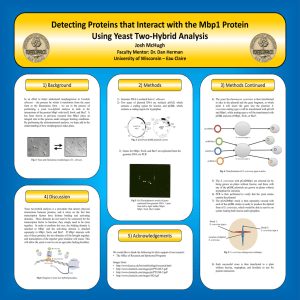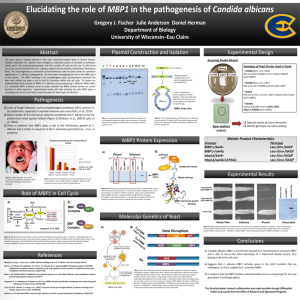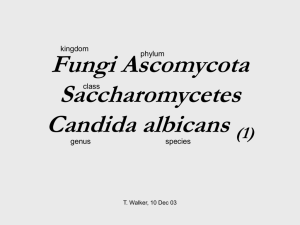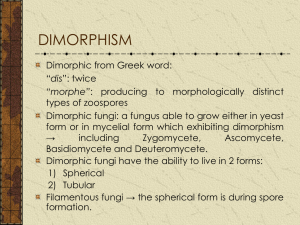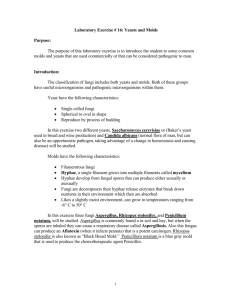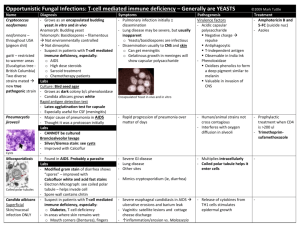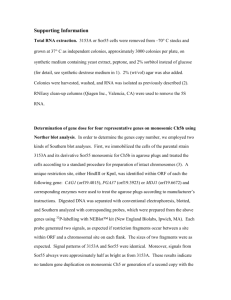RunzheimerSpr13
advertisement
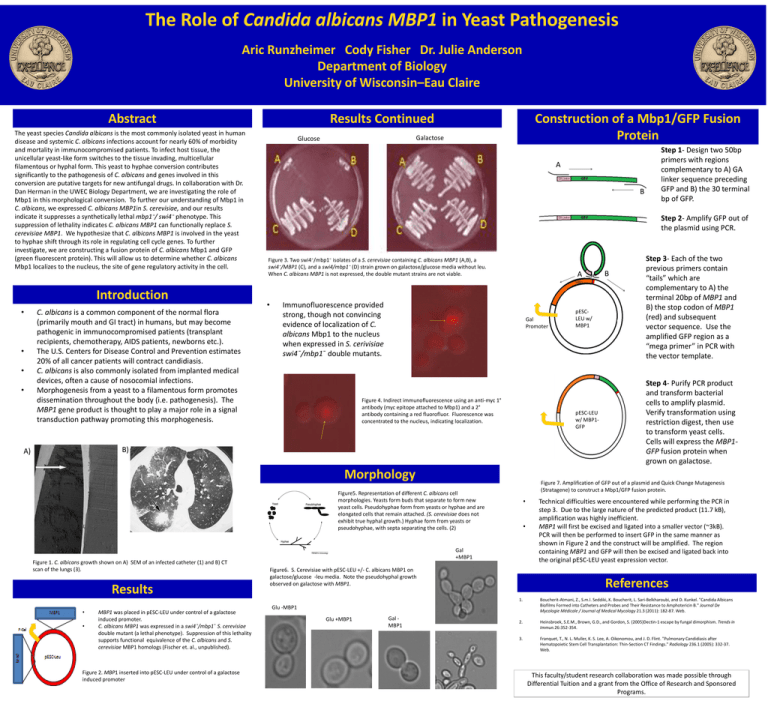
The Role of Candida albicans MBP1 in Yeast Pathogenesis Aric Runzheimer Cody Fisher Dr. Julie Anderson Department of Biology University of Wisconsin–Eau Claire Abstract The yeast species Candida albicans is the most commonly isolated yeast in human disease and systemic C. albicans infections account for nearly 60% of morbidity and mortality in immunocompromised patients. To infect host tissue, the unicellular yeast-like form switches to the tissue invading, multicellular filamentous or hyphal form. This yeast to hyphae conversion contributes significantly to the pathogenesis of C. albicans and genes involved in this conversion are putative targets for new antifungal drugs. In collaboration with Dr. Dan Herman in the UWEC Biology Department, we are investigating the role of Mbp1 in this morphological conversion. To further our understanding of Mbp1 in C. albicans, we expressed C. albicans MBP1in S. cerevisiae, and our results indicate it suppresses a synthetically lethal mbp1⁻/ swi4⁻ phenotype. This suppression of lethality indicates C. albicans MBP1 can functionally replace S. cerevisiae MBP1. We hypothesize that C. albicans MBP1 is involved in the yeast to hyphae shift through its role in regulating cell cycle genes. To further investigate, we are constructing a fusion protein of C. albicans Mbp1 and GFP (green fluorescent protein). This will allow us to determine whether C. albicans Mbp1 localizes to the nucleus, the site of gene regulatory activity in the cell. Introduction • • • • C. albicans is a common component of the normal flora (primarily mouth and GI tract) in humans, but may become pathogenic in immunocompromised patients (transplant recipients, chemotherapy, AIDS patients, newborns etc.). The U.S. Centers for Disease Control and Prevention estimates 20% of all cancer patients will contract candidiasis. C. albicans is also commonly isolated from implanted medical devices, often a cause of nosocomial infections. Morphogenesis from a yeast to a filamentous form promotes dissemination throughout the body (i.e. pathogenesis). The MBP1 gene product is thought to play a major role in a signal transduction pathway promoting this morphogenesis. Results Continued Construction of a Mbp1/GFP Fusion Protein Galactose Glucose A B Step 2- Amplify GFP out of the plasmid using PCR. Figure 3. Two swi4⁻/mbp1⁻ isolates of a S. cerevisiae containing C. albicans MBP1 (A,B), a swi4⁻/MBP1 (C), and a swi4/mbp1⁻ (D) strain grown on galactose/glucose media without leu. When C. albicans MBP1 is not expressed, the double mutant strains are not viable. • A Immunofluorescence provided strong, though not convincing evidence of localization of C. albicans Mbp1 to the nucleus when expressed in S. cerivisiae swi4¯/mbp1¯ double mutants. Gal Promoter Figure 4. Indirect immunofluorescence using an anti-myc 1° antibody (myc epitope attached to Mbp1) and a 2° antibody containing a red fluorofluor. Fluorescence was concentrated to the nucleus, indicating localization. Morphology Results • • MBP1 was placed in pESC-LEU under control of a galactose induced promoter. C. albicans MBP1 was expressed in a swi4¯/mbp1¯ S. cerevisiae double mutant (a lethal phenotype). Suppression of this lethality supports functional equivalence of the C. albicans and S. cerevisiae MBP1 homologs (Fischer et. al., unpublished). Figure 2. MBP1 inserted into pESC-LEU under control of a galactose induced promoter • • Gal +MBP1 Figure6. S. Cerevisiae with pESC-LEU +/- C. albicans MBP1 on galactose/glucose -leu media. Note the pseudohyphal growth observed on galactose with MBP1. n 2n n Gal MBP1 Step 4- Purify PCR product and transform bacterial cells to amplify plasmid. Verify transformation using restriction digest, then use to transform yeast cells. Cells will express the MBP1GFP fusion protein when grown on galactose. Technical difficulties were encountered while performing the PCR in step 3. Due to the large nature of the predicted product (11.7 kB), amplification was highly inefficient. MBP1 will first be excised and ligated into a smaller vector (~3kB). PCR will then be performed to insert GFP in the same manner as shown in Figure 2 and the construct will be amplified. The region containing MBP1 and GFP will then be excised and ligated back into the original pESC-LEU yeast expression vector. References 1. Boucherit-Atmani, Z., S.m.l. Seddiki, K. Boucherit, L. Sari-Belkharoubi, and D. Kunkel. "Candida Albicans Biofilms Formed into Catheters and Probes and Their Resistance to Amphotericin B." Journal De Mycologie Médicale / Journal of Medical Mycology 21.3 (2011): 182-87. Web. 2. Heinsbroek, S.E.M., Brown, G.D., and Gordon, S. (2005)Dectin-1 escape by fungal dimorphism. Trends in Immun.26:352-354. 3. Franquet, T., N. L. Muller, K. S. Lee, A. Oikonomou, and J. D. Flint. "Pulmonary Candidiasis after Hematopoietic Stem Cell Transplantation: Thin-Section CT Findings." Radiology 236.1 (2005): 332-37. Web. Glu -MBP1 Glu +MBP1 B Step 3- Each of the two previous primers contain “tails” which are complementary to A) the terminal 20bp of MBP1 and B) the stop codon of MBP1 (red) and subsequent vector sequence. Use the amplified GFP region as a “mega primer” in PCR with the vector template. Figure 7. Amplification of GFP out of a plasmid and Quick Change Mutagenesis (Stratagene) to construct a Mbp1/GFP fusion protein. Figure5. Representation of different C. albicans cell morphologies. Yeasts form buds that separate to form new yeast cells. Pseudohyphae form from yeasts or hyphae and are elongated cells that remain attached. (S. cerevisiae does not exhibit true hyphal growth.) Hyphae form from yeasts or pseudohyphae, with septa separating the cells. (2) Figure 1. C. albicans growth shown on A) SEM of an infected catheter (1) and B) CT scan of the lungs (3). pESCLEU w/ MBP1 pESC-LEU w/ MBP1GFP B) A) Step 1- Design two 50bp primers with regions complementary to A) GA linker sequence preceding GFP and B) the 30 terminal bp of GFP. This faculty/student research collaboration was made possible through Differential Tuition and a grant from the Office of Research and Sponsored Programs.
